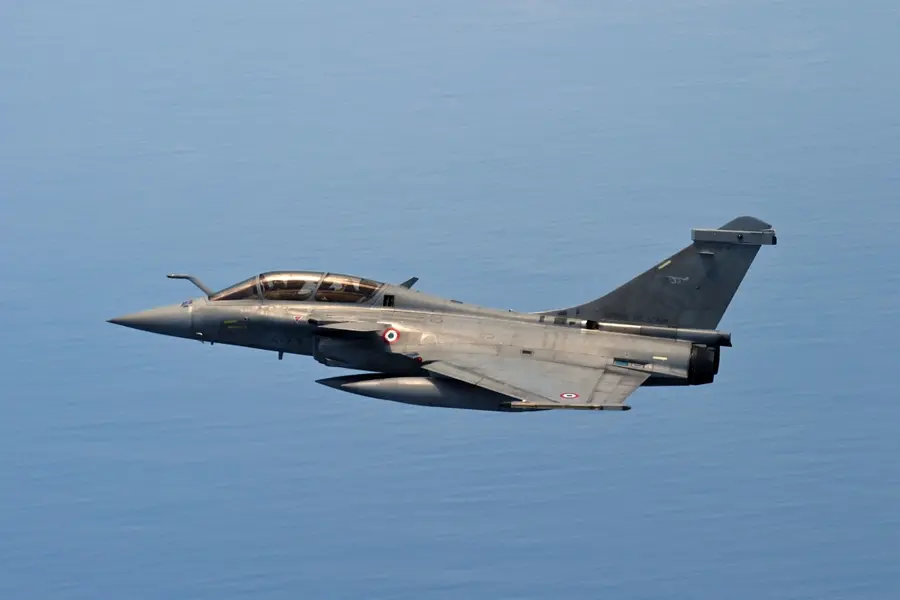SOURCE: AFI


On May 7, 2025, India launched Operation Sindoor, a series of precision airstrikes targeting nine terrorist camps in Pakistan and Pakistan-occupied Kashmir (PoK) in retaliation for a deadly attack in Pahalgam, Indian-administered Kashmir, on April 22. In the wake of the operation, Pakistan’s military and media claimed a stunning victory, alleging that they shot down five Indian Air Force (IAF) aircraft, including three advanced Dassault Rafale fighter jets, during clashes near Wuyan village in Jammu and Kashmir.
These claims, amplified by pro-Pakistan social media accounts, sparked widespread debate. However, a French expert, alongside India’s Press Information Bureau (PIB) and other analysts, has decisively debunked these assertions, exposing them as part of a disinformation campaign.
Pakistan’s military spokesperson, Lt. Gen. Ahmad Sharif Chaudhary, and Foreign Minister Ishaq Dar asserted that Pakistan Air Force (PAF) jets, specifically Chinese-made Chengdu J-10Cs armed with PL-15E air-to-air missiles, downed three Rafales, one MiG-29, one Su-30MKI, and an Israeli-made Heron drone in Indian airspace. Social media posts, including one from user @iihtishamm , claimed to show Rafale debris in Wuyan, with alleged markings from French company Le Bozec et Gautier and the acronym “RFL” (commonly linked to Rafale). Another image, purportedly from Bathinda, Punjab, showed wreckage bearing the serial number BS-001, claimed to be from India’s first Rafale jet.
These claims were further sensationalized by reports from outlets like The Express Tribune and CNN, which cited an unnamed French intelligence official suggesting at least one Rafale was downed. Pakistan’s narrative painted Operation Sindoor as a strategic failure for India, with some Western media, including Reuters and The Washington Post, initially lending credence to the idea of Indian losses.
A French aerospace expert, cited in The EurAsian Times and France 24’s Observers, has dismantled Pakistan’s claims with technical precision. Analyzing images from Wuyan, the expert identified the alleged “Rafale debris” as an external fuel tank, not evidence of a downed aircraft. Crucially, the tank bore the acronym “RPL” (réservoir pendulaire largable, meaning jettisonable external tank) rather than “RFL,” and was manufactured in December 1984—over a year before the Rafale’s first test flight in 1986. This timeline strongly suggests the tank belonged to a Mirage 2000, another French-made jet in the IAF’s fleet, which entered service in the 1980s.
The expert emphasized, “These images are not proof that a plane was shot down. It shows a drop tank. When a jet goes on a mission, once it has used its fuel, it will lighten its load and drop its tank. It’s something planes intentionally release during their missions.” Trevor Ball, an associate researcher at Armament Research Services, corroborated this, noting that the Wuyan debris was consistent with a Mirage 2000 or Rafale fuel tank but did not indicate a crash.
India’s PIB Fact Check unit swiftly countered Pakistan’s claims, labeling them as propaganda. A viral image circulating on pro-Pakistan social media, purportedly showing a downed Rafale near Bahawalpur, was identified as a 2021 photo of an IAF MiG-21 crash in Moga, Punjab. Another image, claimed to depict a Rafale on fire, was traced to a 2024 MiG-29 crash in Rajasthan. PIB also debunked a video alleging a PAF attack on Srinagar Airbase, confirming it was from 2024 sectarian clashes in Pakistan’s Khyber Pakhtunkhwa.
The Indian government has not officially acknowledged any aircraft losses during Operation Sindoor. A senior IAF official, during a May 11 press brief, stated that “losses are part of combat operations” but provided no specifics, fueling speculation. However, India’s silence contrasts with its proactive debunking of Pakistan’s visual evidence, suggesting confidence in the operation’s success.
Analyzing the Evidence: Why Pakistan’s Claims Fall Apart
Several factors undermine Pakistan’s narrative:
- Lack of Verifiable Evidence: Pakistan has failed to produce credible video footage, satellite imagery, or wreckage conclusively tied to a Rafale. Claims of a tailfin with serial number BS-001, reported by Flight Global, raised doubts due to discrepancies in the rudder’s text and seam alignment, suggesting possible manipulation.
- Technical Implausibility: The Rafale, a 4.5-generation stealth fighter, is equipped with advanced electronic countermeasures and MBDA Meteor missiles, making it a formidable opponent. Pakistan’s claim of downing three Rafales with J-10Cs, using PL-15E missiles with a 145-kilometer range, lacks corroboration. Analysts like Carnegie’s Ashley Tellis suggested one Rafale might have been lost in an ultra-long-range engagement, but even this remains unverified.
- Drop Tank Misidentification: The Wuyan fuel tank, dated to 1984, predates the Rafale program, aligning with the Mirage 2000’s timeline. Dropped tanks are standard in combat to reduce weight, not evidence of a shootdown.
- Western Media Bias?: Some Indian analysts, as noted in The EurAsian Times, suspect Western media’s haste in reporting Rafale losses reflects commercial motives, possibly to promote U.S.-made F-35s over Rafales in India’s upcoming 114-fighter MRFA deal. This aligns with former Ambassador Jawed Ashraf’s remarks about Western media targeting Indian aerospace achievements, like the HAL Tejas, to curb competition.
Globally, the incident has drawn attention from nations like Taiwan, where Chinese bloggers cited the alleged Rafale shootdown to tout the J-10C’s superiority, raising concerns about Chinese military capabilities. However, Taiwan’s government has not commented, and the lack of concrete evidence weakens these claims.
NOTE: AFI is a proud outsourced content creator partner of IDRW.ORG. All content created by AFI is the sole property of AFI and is protected by copyright. AFI takes copyright infringement seriously and will pursue all legal options available to protect its content.